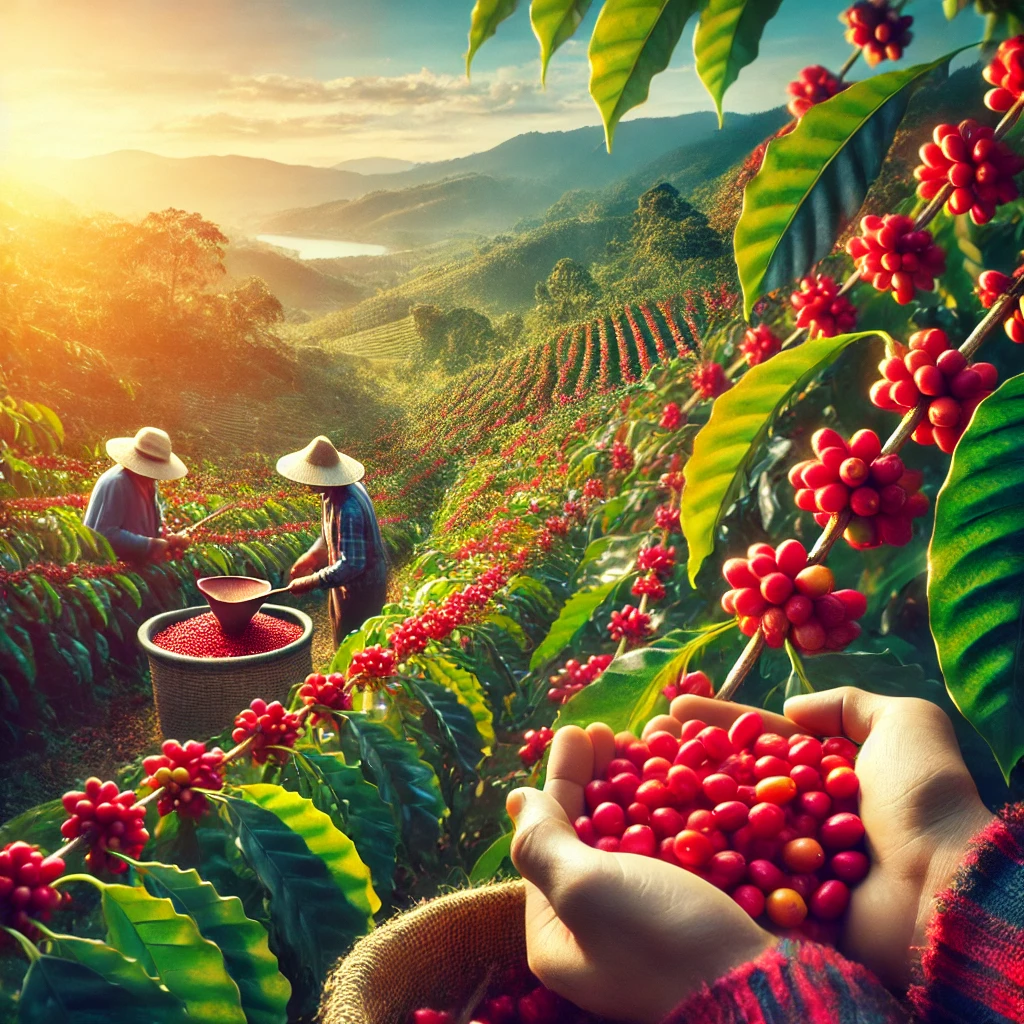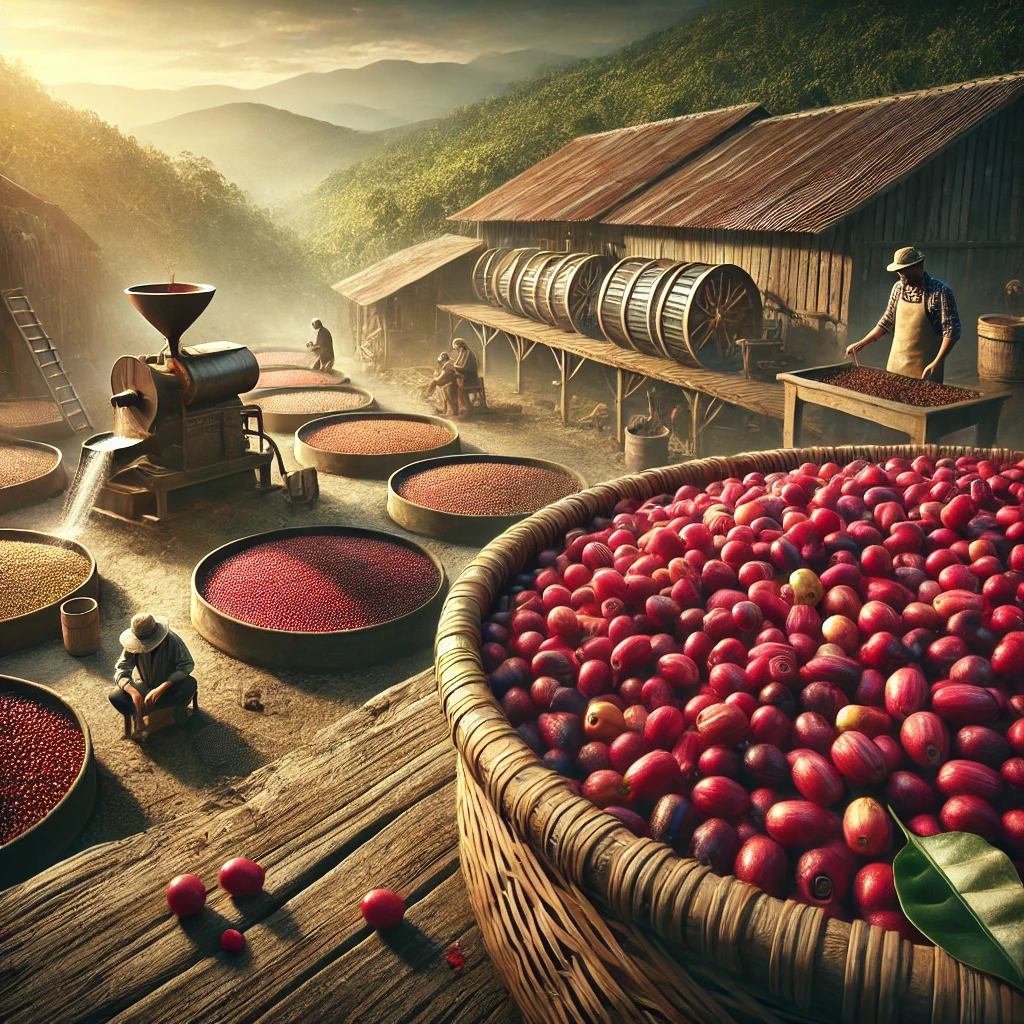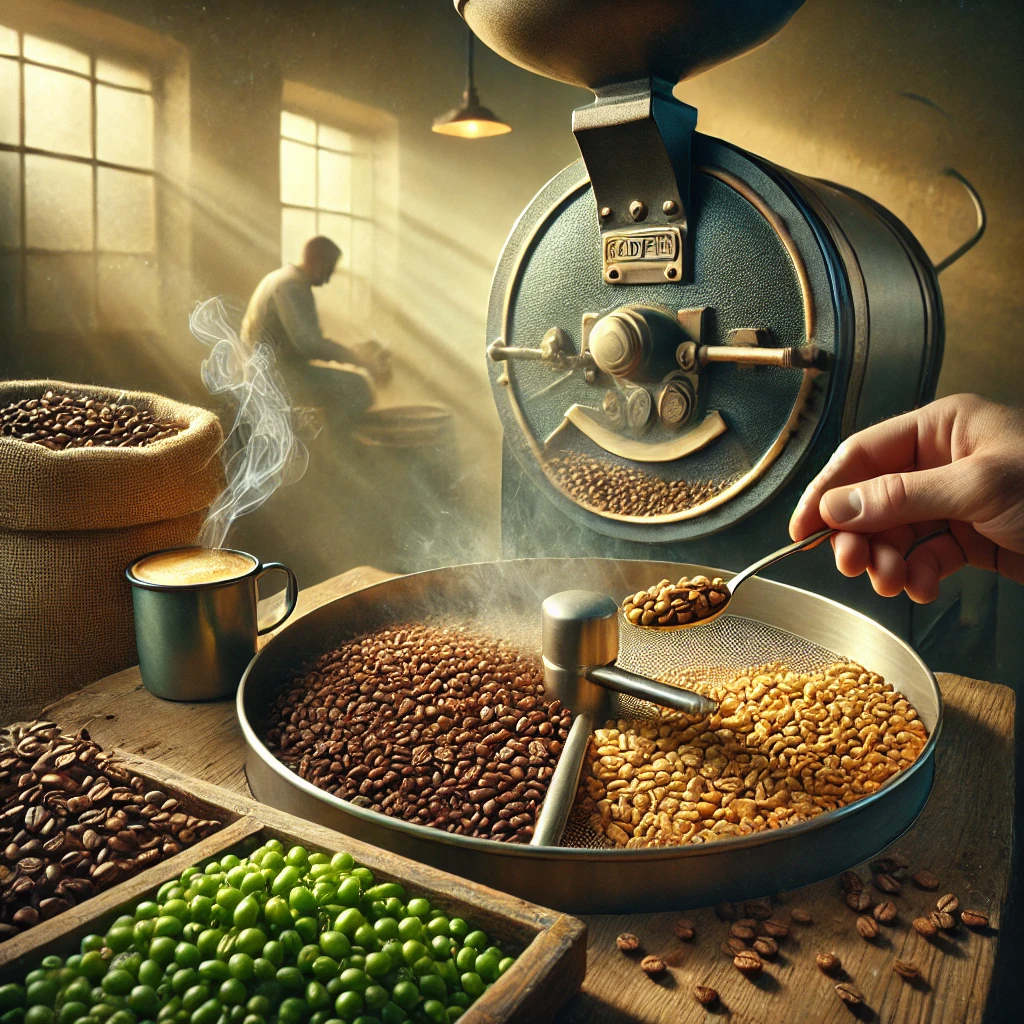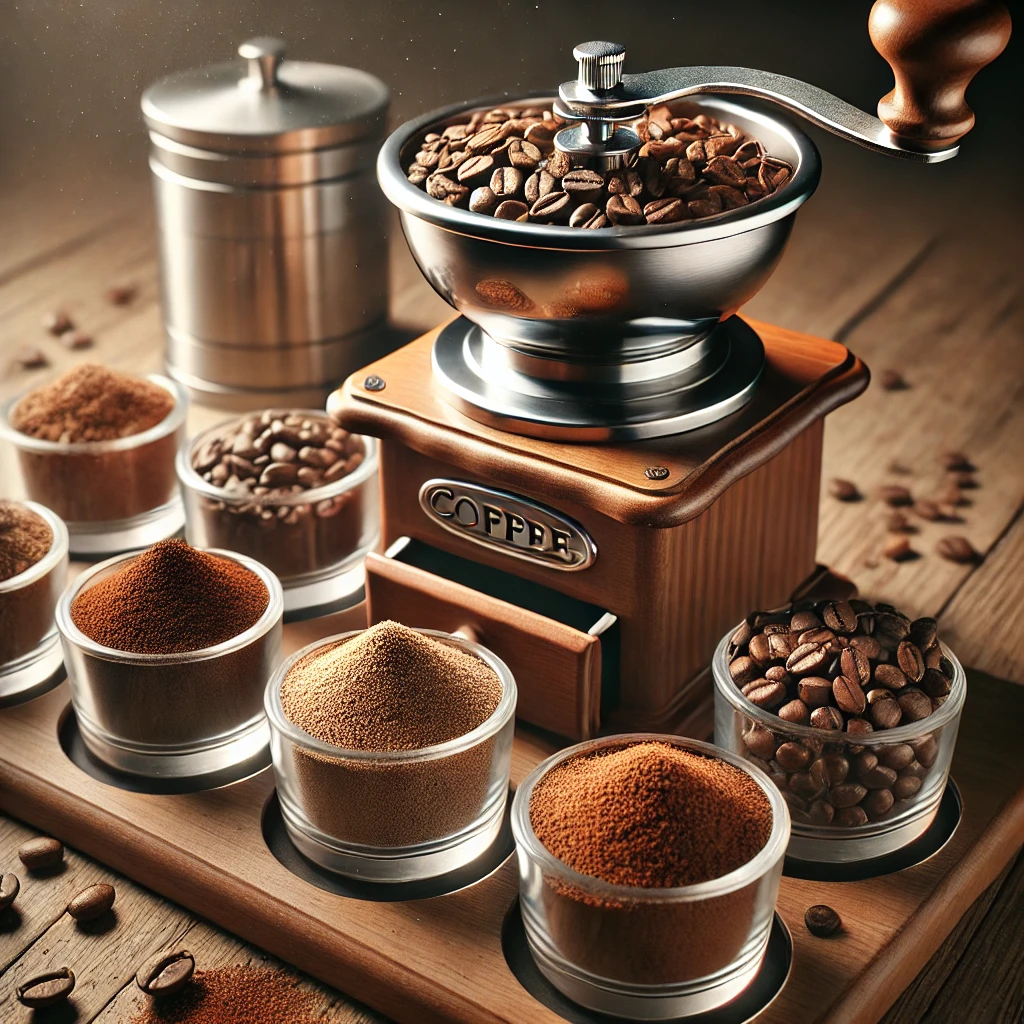The Journey of Coffee
Coffee goes through an incredible journey before it reaches your cup. From cultivation in tropical regions to the precise art of brewing, each step contributes to the complex flavors we enjoy.
The Coffee Journey
Growing
Coffee plants take 3-5 years to mature and produce their first harvest.
Harvesting
Coffee cherries are hand-picked when they reach perfect ripeness.
Processing
The cherries are processed to remove the outer layers and extract the beans.
Drying
Beans are dried to reduce moisture content and prepare for storage.
Roasting
Beans are roasted to develop their unique flavor profiles.
Grinding
Roasted beans are ground to the perfect consistency for brewing.
Brewing
The final step to create your perfect cup of coffee.
Understanding Each Step

Growing
Coffee plants take 3-5 years to mature and produce their first harvest.
Coffee plants are cultivated in over 50 countries in what's known as the 'Bean Belt', the area between the Tropics of Cancer and Capricorn. These evergreen shrubs grow best at high altitudes, in rich soil, and in moderate temperatures with abundant rainfall. The plants need specific conditions to thrive : shade, humidity, and protection from frost.
Coffee plants typically take 3-5 years to mature and begin producing fruit, known as coffee cherries. The two most commercially important species are Coffea arabica (Arabica) and Coffea canephora (Robusta). Arabica accounts for about 60-70% of global production and is known for its nuanced flavors, while Robusta has higher caffeine content and more resistance to pests and diseases.

Harvesting
Coffee cherries are hand-picked when they reach perfect ripeness.
The harvest season varies by region and climate, but generally, coffee cherries are harvested when they turn a bright, deep red color indicating peak ripeness. There are two primary methods of harvesting :
Selective Picking : This traditional method involves hand-picking only the ripe cherries, leaving the unripe ones for later collection. It's labor-intensive but ensures the highest quality, as only perfectly ripe cherries are selected.
Strip Picking : In this method, all cherries are stripped off the branch at once, regardless of ripeness. While more efficient, it results in a mixture of ripe and unripe cherries that must be sorted later.
In regions with flat terrain and large plantations, mechanical harvesters might be used, but for specialty coffee and in mountainous regions, selective hand-picking remains the preferred method to ensure quality.

Processing
The cherries are processed to remove the outer layers and extract the beans.
After harvesting, coffee cherries must be processed quickly to prevent spoilage. The processing method significantly impacts the final flavor profile of the coffee. There are three main methods :
Dry (Natural) Process : The oldest method, where whole cherries are spread out in the sun to dry for 2-4 weeks, being regularly turned and protected from moisture. The dried cherries are then hulled to remove the dried pulp and parchment layer, revealing the green coffee bean. This method typically produces coffees with fruity, complex flavors and heavier body.
Wet (Washed) Process : Cherries are mechanically depulped to remove the outer skin and pulp, then fermented in water tanks to break down any remaining fruit flesh. After fermentation, the beans are washed and dried. This process typically yields coffees with cleaner, brighter flavors and more pronounced acidity.
Honey (Pulped Natural) Process : A hybrid method where the skin is removed, but some or all of the fruit mucilage is left on the bean during drying. Depending on how much mucilage remains, the process may be classified as 'white honey', 'yellow honey', 'red honey', or 'black honey'. This method produces coffees with characteristics between natural and washed coffees.

Drying
Beans are dried to reduce moisture content and prepare for storage.
Proper drying is critical in coffee production, as it affects both the coffee's shelf life and flavor development. The goal is to reduce the moisture content of the beans from approximately 60% to between 10-12%.
Sun Drying : In traditional production, coffee is dried on large patios or raised beds, where it's spread in thin layers and regularly turned to ensure even drying. This method can take 1-2 weeks depending on weather conditions.
Mechanical Drying : In regions with unpredictable weather or for larger operations, mechanical dryers may be used to accelerate and control the drying process. These must be carefully managed to avoid drying too quickly, which can lead to inconsistent moisture levels within the bean.
During drying, coffee must be protected from rainfall and moisture. The beans are regularly tested for moisture content using specialized meters. Once properly dried, the coffee is often stored in its parchment layer (the thin, paper-like covering around the bean) until it's ready for hulling, which removes this protective layer before export.

Roasting
Beans are roasted to develop their unique flavor profiles.
Roasting transforms the physical and chemical properties of green coffee beans into aromatic brown beans, significantly influencing the coffee's final flavor profile. The roasting process typically involves temperatures between 180-240°C (356-464°F) and can last from 8-15 minutes, depending on the desired roast level.
During roasting, beans undergo several stages, starting with an endothermic phase where they absorb heat and turn yellowish, developing a grassy smell. As internal bean temperature rises, it enters an exothermic phase called first crack (a popping sound similar to popcorn), marking the beginning of light roasts. Continued roasting develops more oils on the surface and darker colors, eventually reaching second crack for dark roasts.
Roast Levels : The spectrum of roasts varies from light (bright acidity, pronounced origin characteristics) to medium (balanced flavor, increased body) to dark (pronounced bitterness, decreased acidity, more roast flavor). The roaster must carefully control time, temperature, and airflow to achieve the desired flavor profile, often using sight, sound, and smell as guides alongside technical monitoring equipment.

Grinding
Roasted beans are ground to the perfect consistency for brewing.
Coffee grinding breaks down roasted beans into smaller particles, increasing surface area for water to extract flavors, aromas, and compounds. The grind size significantly impacts extraction and flavor, making it a critical variable in brewing excellent coffee.
Grind Sizes : The spectrum ranges from extra-fine (powdery, like flour) to extra-coarse (chunky, like peppercorns), with each brewing method requiring a specific grind size for optimal extraction:
• Extra-fine : Turkish coffee • Fine: Espresso • Medium-fine: AeroPress, some pour-over methods • Medium: Drip coffee machines, pour-over methods • Medium-coarse: Chemex, clever dripper • Coarse: French press, cold brew
Grinder Types : Burr grinders are preferred over blade grinders for their ability to produce consistent particle sizes. High-quality burr grinders use either flat or conical burrs made of ceramic or steel. Freshly ground coffee is ideal, as grinding accelerates oxidation and flavor deterioration. For optimal results, coffee should be ground immediately before brewing.

Brewing
The final step to create your perfect cup of coffee.
Brewing is where science and art converge to extract the optimal flavors from ground coffee. The process involves combining ground coffee with water at the right temperature for an appropriate amount of time. Several factors affect extraction quality :
Water Quality : Coffee is 98% water, so pure, filtered water with the right mineral content (75-250 ppm total dissolved solids) is crucial.
Water Temperature : The ideal range is 90-96°C (195-205°F). Too hot burns the coffee; too cool under-extracts it.
Brewing Ratio : The coffee-to-water ratio affects strength and extraction. Common ratios range from 1:15 to 1:18 (one part coffee to 15-18 parts water by weight).
Brewing Time : Varies by method, from 25-30 seconds for espresso to 4 minutes for pour-over or French press, and 12+ hours for cold brew.
Brewing Methods : Popular techniques include 'espresso' (pressurized hot water through finely-ground coffee), 'pour-over' (hot water poured over coffee in a filter), 'French press' (immersion method using a plunger), 'AeroPress' (pressure and immersion hybrid), 'cold brew' (long steeping in cold water), and many others. Each method highlights different characteristics of the coffee, from acidity and brightness to body and richness.